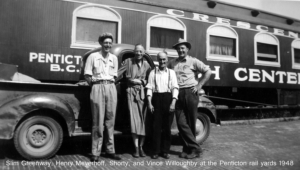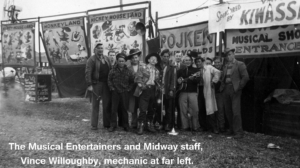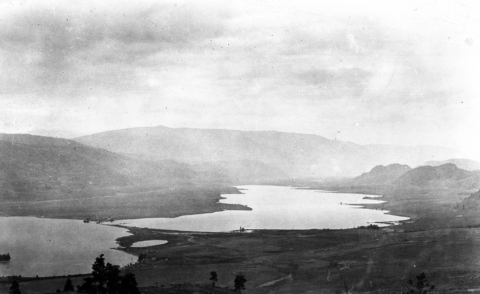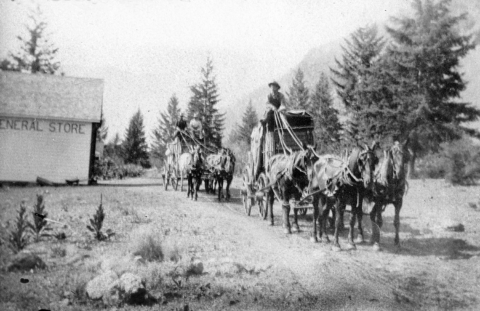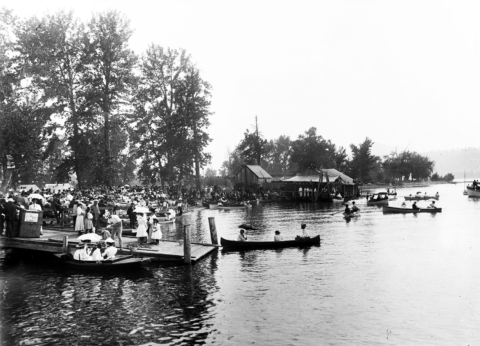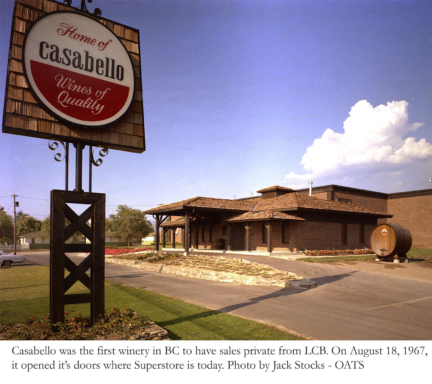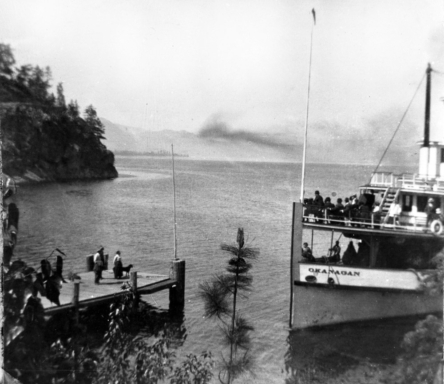Henry Meyerhoff’s roots were in the German-American state of Wisconsin. His father had settled in the small city of Green Bay and ran a small travelling show he called “Herman Meyerhoff’s Dramatic and Variety Show.” It featured a little of everything from a dog and pony show to comic operas.
Henry was born on the show site in 1884. As with all good immigrant families, the bright lights of the big city called to them. The show finally ended up on Eldridge Street, near the Bowery of New York City. The show garnered acclaim as a centre for “hokum” acts, which are those staring local amateur performers who were paid $2 for a nights work.
Unfortunately, Herman Meyerhoff died suddenly in 1899 leaving the family destitute. The 15 year old Henry was thrown into the position of owner of a broke travelling show. Past performers and current staff came forward to help the family keep what they could of the show together and to train Henry in the operation of the show. By 1904, he was ready to try it on the road.
The show travelled to all the large and mid-size cities on the Eastern seaboard and even to Ottawa. Strangely, this is where Henry first heard of “Penticton”. In 1916, while on Canadian tour, he bought some Penticton District Municipal Bonds. Where they came from was not to enter Henry’s mind until 1933.
They were treated very well in Ottawa and it was here that Henry changed the name of the troupe to “Crescent Shows”, mostly because of debts still owed to American sponsors. Soon after it was decided to remain in Ottawa and make it the headquarters to tour Canadian cities. They stayed in Eastern Canada and toured from Sydney to Winsor for over 20 years. In those years they were a central feature of the Canadian National Exposition in Toronto.
Henry had always had problems at the border with customs duties and permits as he was an American operating in Canada. It was suggested that there was a major savings to this procedure if he were to become a Canadian. In application he had to agree to keep a 75% ratio of Canadian employees and he would say these heavy charges. So in 1932 Henry became a Canadian.
But the 1930’s were cruel to the show and when Henry ended up in Timmins, it was the end. He looked back to the road east, and said to the troupe. “West?” Off to the western provinces they went. With $50 and those Penticton bonds, they arrived in Penticton in September that year. They squatted in a farmer’s field south of town.
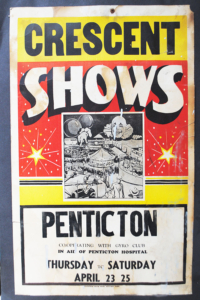
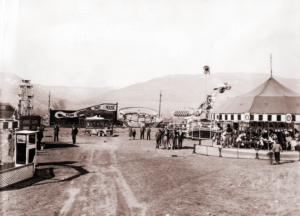
Henry soon went to city hall to apply for a licence to set up the show on the site and was refused. Many good citizens wanted nothing to do with a travelling gypsy show in their town. With no money to move on, Henry was in a real fix. He went to local businesses to ask for credit and was much surprized that all of them were willing to help him out. He would never forget their generosity. He went back to city hall and held up the Penticton Bonds as his faith in the community. Alderman J.W. Johnson stepped up and spoke on behalf of Meyerhoff and the council agreed to grant a licence.
The struggles of the depression did cause Crescent Shows to go into bankruptcy in 1939, but Henry persevered and paid his debtors with interest. He could never let them down after their kindness.
During these years, and with the assistance of his aged mother, he adopted two sisters from a friend’s family. Rose Marie and Joan grew up in the travelling show until they were old enough to go to Strathcona School for Girls at Shawnigan Lake. Henry had never married as he didn’t think he had time, but after much pressure from the girls, who wanted a mother, he pursued one of the ladies from the Dancing McDonalds troupe, Maud. They were married in 1946.
Success was his in the 1940’s. He chose the right acts, the right animals and the right concessions. He purchased a 10 acre plot of land on the corner of Calgary Avenue and Main Street where he built a home and large barn to house his animals. The Circus portion of his show always had elephants, zebras, camels, lots of horses and the odd big cat. His could now winter in mild quarters and then begin the season with a local event.
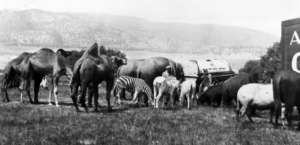
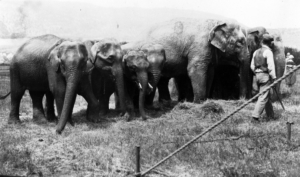
From 1941 to 1950 he did just that. In April every year he would set up his carnival and circus and play to the locals for 2 or 3 weeks. He then would load the whole thing on railcars and head for Victoria or Edmonton. As the season ended, he would return to Penticton and set the carnival back up for a stint in October before packing it away for the winter. Penticton was one of very few small towns with a Circus twice a year.
In 1941, Henry Meyerhoff was a very generous man and he donated $1000 from receipts to the Penticton Red Cross for the troops overseas.
His travelling show originally leased 11 railcars from CPR, including 2 sleeper cars for his family and managers. By 1945, that increased to 20 cars. It was not unusual to transport a show this way but it was unusual to carry as much livestock as his Carnival did.
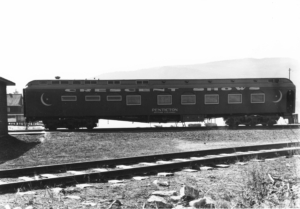

The show began with eight rides, Rollo Fun House, 20 concessions and Seller’s Pony ride, hauling 5 kids at a time in a cart. Meyerhoff could add acts to the show depending on the audience size. For example, Vancouver would be a larger show than Nanaimo. A few acts would join him from as far away as Arizona; people like producer John Kazlowski would design that year’s music and indoor shows for Henry, then move on to the next circus. In 1947, Henry added a Rat Show, a Mouse Circus and Monkeyland.
In 1948, Henry placed an advertisement in Billboard Magazine which stated:
“Showmen…Circus Operators…Animal Dealers…I am sailing mid-September to India, Tripurastate, Borneo, Agra, Thailand, Pakistan, Malaya, Neighboring Islands and Countries, in search of Strange and Interesting People and Freaks. Elephants full-grown, Baby Tigers, Baboons, Monkeys, large Reptiles. I have definitely secured export permits to export TWO SACRED WHITE ELEPHANTS and other animals to USA, Pacific or East Coast Ports. I will act as purchasing agent for reliable show people at ten per cent commission and unbelievable low prices. Contact me if interested, till September 15th.”
Henry was asked to join a planning committee for the organization of an annual festival for Penticton. The committee wanted to call this festival “Mardi gras” but Meyerhoff stepped up and stated “This is the peach centre of the world. We should call it Peach Festival.”
Mr. Meyerhoff’s generosity seemed to know no bounds. He built a public playground. He provided annual scholarships to Pen High in the value of $250 each, which was a small fortune in the 1940’s. He did this year after year for the school as he did for the Legion, St. John’s Ambulance and many more non-profit organizations. When the 1948 flood damaged the show, he donated $8000 to the B.C. Flood Relief Fund.
He was awarded Penticton’s “Citizen of the Year” recognition award for 1949.
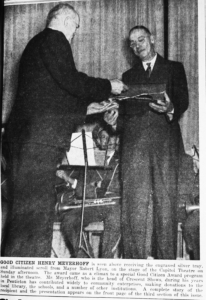
These gifts continued flow for most of his working life. But as his girls got older and graduated, he started thinking of retirement. Rosemarie was working at the Starlight Theatre on Skaha beach for summers and Joan had no interest in the show. So in 1950, he sold the Carnival to friends, Ab Greenway and Tiny Nicholls of Gayland Shows. They sent out the combined carnival as “Garrett Shows.” Henry continued with the show as manager until 1953.
During this time, he put together the “Henry Meyerhoff Scholarship Trust” with $300,000 of capital from the sale of the show and from donations from other show operators. Meyerhoff said, “Besides being a fine thing for the students who win the scholarships, it will create better feelings for show operators and I consider it money well spent.”
Twenty two separate communities in three western provinces had awards each year. But the fund strangely dried up and was discontinued a few years later. It was due to the default of payments of the sale of the show by Greenway and Gayland Shows. Henry took a portion of the show back in 1958. First he tried to sell it with no luck, then went back on the circuit for a couple of years. He was 76 years old.
Mr. Meyerhoff sold his property for the Penticton Plaza shopping centre in 1958 but kept the house lot separate. He lived in the house on the corner of Calgary Avenue until his death in 1962.

